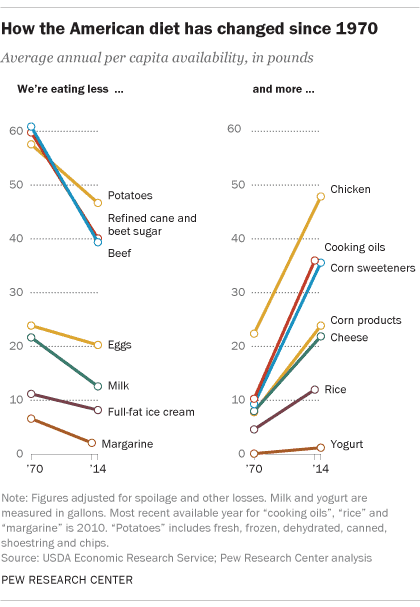
"In Pew Research Center’s recent survey on food and nutrition attitudes, 54% of Americans said people in the U.S. pay more attention to eating healthy foods today compared with 20 years ago – the same percentage who said Americans’ actual eating habits are less healthy today than they were 20 years ago. And while 73% of Americans said they were very or fairly focused on healthy and nutritious eating, 58% said that most days they probably should be eating healthier."
"So how do Americans really eat, and how has that changed over time? We analyzed data from the USDA’s Food Availability (Per Capita) Data System, or FADS, to find out."
"Americans eat more chicken and less beef than they used to. They drink less milk – especially whole milk – and eat less ice cream, but they consume way more cheese. Their diets include less sugar than in prior decades but a lot more corn-derived sweeteners. And while the average American eats the equivalent of 1.2 gallons of yogurt a year, he or she also consumes 36 pounds of cooking oils – more than three times as much as in the early 1970s. Americans’ eating habits, in short, are all over the place, at least according to our analysis of U.S. Department of Agriculture data," Drew Desilver wrote for Pew Research.
Grocers can help consumers make healthier choices through advertising. The latest AudienceSCAN survey found 25.7% of adults are willing to pay more for healthy or organic food products.
"Broadly speaking, we eat a lot more than we used to: The average American consumed 2,481 calories a day in 2010, about 23% more than in 1970. That’s more than most adults need to maintain their current weight, according to the Mayo Clinic’s calorie calculator. (A 40-year-old man of average height and weight who’s moderately active, for instance, needs 2,400 calories; a 40-year-old woman with corresponding characteristics needs 1,850 calories.)"
"Nearly half of those calories come from just two food groups: flours and grains (581 calories, or 23.4%) and fats and oils (575, or 23.2%), up from a combined 37.3% in 1970. Meats, dairy and sweeteners provide smaller shares of our daily caloric intake than they did four decades ago; then again, so do fruits and vegetables (7.9% in 2010 versus 9.2% in 1970)."
Advertisers could focus on the "healthy" and organic alternatives to the staples Americans are buying already. Newspaper (print, online, mobile or tablet) ads were effective in persuading 28.6% of Healthy/Organic Shoppers to take action in the past month, according to current AudienceSCAN data.
"Several interesting shifts are happening within food groups. For the past decade, for instance, chicken has topped beef as the most-consumed meat. In 2014, Americans ate an average of 47.9 pounds of chicken a year (2.1 ounces a day), versus 39.4 pounds (1.7 ounces a day) of beef. While average chicken consumption has more than doubled since 1970, beef has fallen by more than a third."
"Over in the dairy aisle, Americans are drinking 42% less milk than they did in 1970: 12.6 gallons a year, equivalent to 4.8 ounces a day. However, we’re eating a lot more cheese: 21.9 pounds a year, nearly three times the average annual consumption in 1970. And yogurt has soared in popularity, from negligible levels in 1970 to almost 1.2 gallons per person per year in 2014 – a 1,700% increase."
AudienceSCAN data is available as part of a subscription to AdMall for Agencies, or with the SalesFuel API. Media companies can access AudienceSCAN data through the AudienceSCAN Reports in AdMall.
